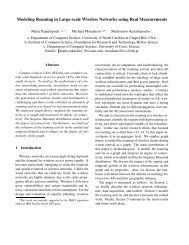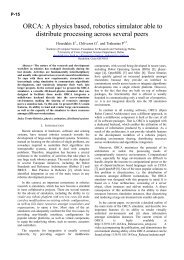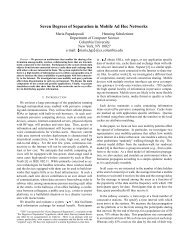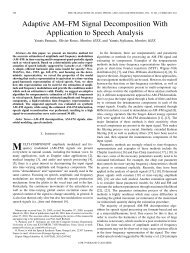Master Thesis - ICS
Master Thesis - ICS
Master Thesis - ICS
Create successful ePaper yourself
Turn your PDF publications into a flip-book with our unique Google optimized e-Paper software.
Computer Science Department<br />
Antonis Misargopoulos<br />
example, if a user has the right to use sites A and B, the user should be able to use sites A<br />
and B together without requiring that A’s and B’s security administrators interact.<br />
Grid security solutions should also provide flexible support for communication<br />
protection e.g. control over the degree of protection, independent data unit protection for<br />
unreliable protocols, support for reliable transport protocols other than TCP, and enable<br />
stakeholder control over authorization decisions, including the ability to restrict the<br />
delegation of rights in various ways.<br />
2.4.3 Resource: Sharing single Resources<br />
The Resource layer builds on the Connectivity layer communication and authentication<br />
protocols to define protocols (and APIs and SDKs) for the secure negotiation, initiation,<br />
monitoring, control, accounting, and payment of sharing operations on individual<br />
resources. Resource layer implementations of these protocols call Fabric layer functions<br />
to access and control local resources. Resource layer protocols are concerned entirely<br />
with individual resources and hence ignore issues of global state and atomic actions<br />
across distributed collections; such issues are the concern of the Collective layer<br />
discussed below. Two primary classes of Resource layer protocols can be distinguished:<br />
• Information protocols are used to obtain information about the structure and state of a<br />
resource, for example, its configuration, current load, and usage policy e.g. cost.<br />
• Management protocols are used to negotiate access to a shared resource, specifying, for<br />
example, resource requirements (including advanced reservation and quality of service)<br />
and the operation(s) to be performed, such as process creation, or data access. Since<br />
management protocols are responsible for instantiating sharing relationships, they must<br />
serve as a policy application point, ensuring that the requested protocol operations are<br />
consistent with the policy under which the resource is to be shared. Issues that must be<br />
considered include accounting and payment. A protocol may also support monitoring the<br />
status of an operation and controlling (like as terminating) the operation. While many<br />
such protocols can be imagined, the Resource (and Connectivity) protocol layers form the<br />
neck of our hourglass model, and as such should be limited to a small and focused set.<br />
These protocols must be chosen so as to capture the fundamental mechanisms of sharing<br />
across many different resource types e.g. different local resource management systems,<br />
16

















